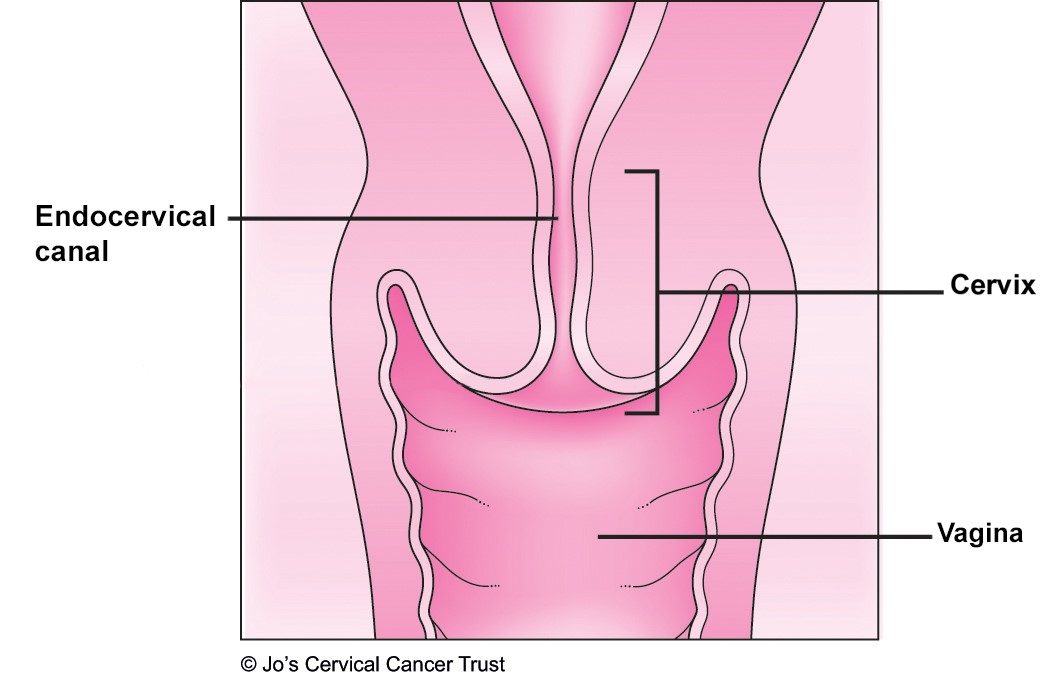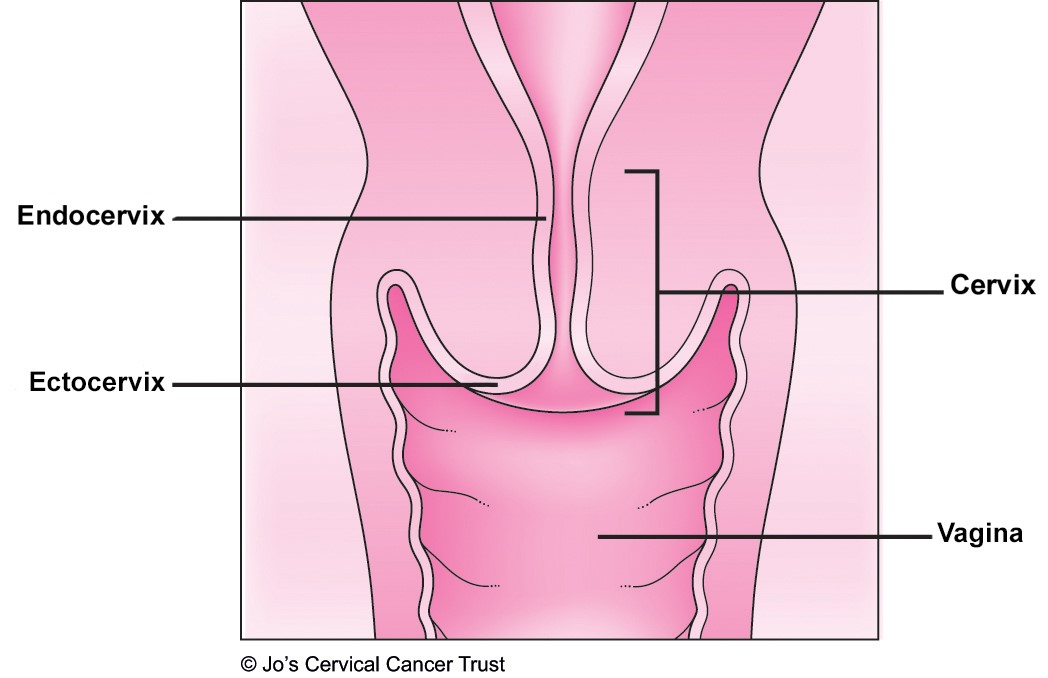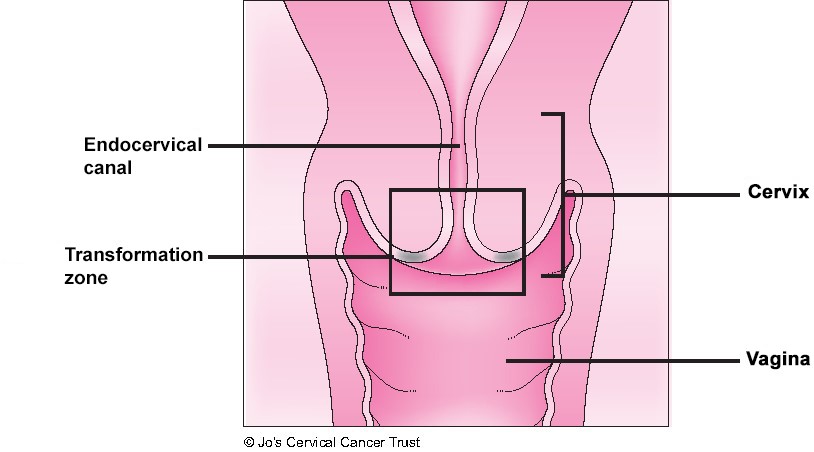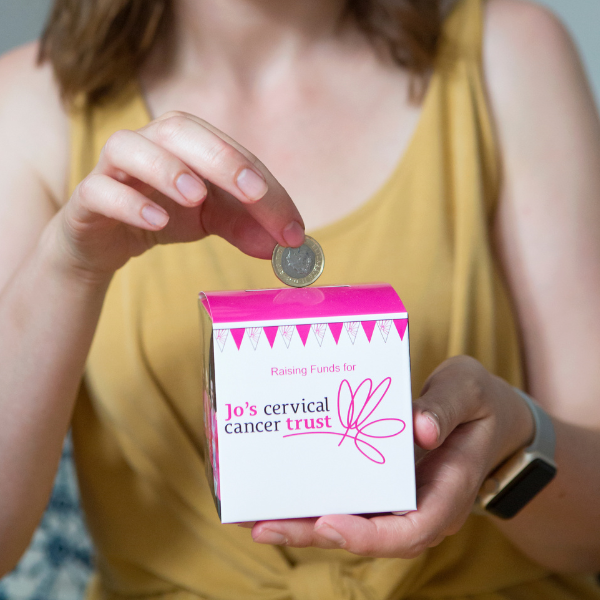The cervix
Last modified: 11 June 2025, 13:15
The cervix is inside the body as a part of the female reproductive system. It joins the top of the vagina to the lower part of the womb.
We also have information on:
Who has a cervix?
Women are usually born with a cervix.
You may have a cervix if you are:
- a trans man and/or non-binary person who was assigned female at birth
- a man who has a difference in sex development (DSD) or is intersex.
In rare cases, women with DSD or who are intersex may be born without a cervix.
If you have had surgery, such as a hysterectomy, you may have had your cervix removed.
If you are not sure whether you have a cervix, it is best to speak with your GP.
Where is the cervix?
The cervix is part of the female reproductive system. The female reproductive system is made up of the:
- vagina
- womb (uterus)
- cervix
- ovaries
- fallopian tubes.
The image below shows where these organs are in the body.
The female reproductive system
What is the structure of the cervix?
The cervix is a small round organ, with an opening called the os.
The cervix forms a canal, which joins the top of the vagina to the lower part of the womb. This is called the endocervical canal.
The cervix

The cervix is divided into the:
- ectocervix – the outer surface of the cervix.
- endocervix – the inside of the cervix.
Ectocervix and endocervix

Types of cells
The types of cells that form the cervix are:
- squamous cells – flat, thin cells that look like skin and cover the outer surface of the cervix
- glandular cells – cells shaped like columns that make a fluid called mucus and cover the inside of the cervix.
Types of cells
Transformation zone
The transformation zone is the area where glandular cells and squamous cells meet. It is found around the opening of the cervix.
The transformation zone is where the nurse or doctor will take a sample of cervical cells from during cervical screening (a smear test).
Read more about cervical screening >
The transformation zone

What does the cervix do?
The cervix has an important role in the female reproductive system.
Menstrual cycle (periods)
If you have a regular period, the lining of the womb sheds as blood each month. The cervix opens to allow the blood to flow out of the vagina. This is an important part of the menstrual cycle because, if the cervix didn’t open, blood would build up in the womb.
Protecting against infection
Glandular cells in the cervix make a fluid called mucus. The mucus is usually clear or white and there may be more of it at different times in the menstrual cycle. It is sometimes called cervical discharge.
This mucus keeps the cervix, womb, ovaries and fallopian tubes healthy by helping protect them from bacteria that could cause infection.
Read more about cervical discharge on the NHS website >
Pregnancy and giving birth
During a part of the menstrual cycle called ovulation, the mucus made by the cervix becomes thinner. This allows sperm to travel up the fallopian tube to fertilise an egg.
During pregnancy, the cervix closes to help protect and keep the baby inside the womb until it is ready to be born. Without this barrier, the baby could be born before it is ready (prematurely) or lost (miscarriage).
When the baby is ready to be born, the cervix stretches and softens to allow the baby to move from the womb to the vagina.
The cervix FAQs
Just like everyone’s body is different, cervixes are different too. What is normal for you may not be the same as someone else.
If you have had cervical screening or a pelvic examination, your doctor or nurse may have said your cervix is lumpy or harder to find (tilted). This can sound worrying, but having lumps or a tilted cervix is common.
The lumps are usually small growths, such as Nabothian cysts or cervical polyps, and they do not cause any harm.
A tilted cervix leans towards the back of the body, which could make it harder to see during cervical screening. Your nurse may suggest that you lie in a different position to help them see your cervix.
If you are worried about any lumps or a tilted cervix, it is important to speak with your GP. They can examine you and make sure you get the right care.
A rare condition called Mayer Rokitansky Küster Hauser (MRKH) syndrome affects the development of the female reproductive system. People with MRKH syndrome may be born without a vagina, womb or cervix.
If you are worried or have any questions about MRKH syndrome, it is best to speak with your GP.
A rare condition called Müllerian duct anomalies affects the development of the female reproductive system. People with this condition may be born with 2 wombs and cervixes.
If you are worried or have any questions about Müllerian duct anomalies, it is best to speak with your GP.
How we can help
If you have general questions about the cervix or cervical screening (smear test), or just want to talk thing through, we are here for you. You can call our Helpline on 0808 802 8000 to speak with our trained volunteers.
Check our Helpline opening hours >
Sometimes it can help to connect with others who are going through or have gone through the same experience. If you think this might help, join our Forum – you can write a post or just read what others are talking about.
Thank you to all the experts who checked the accuracy of this information, and the volunteers who shared their personal experience to help us develop it.
References
- Patel, J. M., et al (2019). Gynecologic cancer screening in the transgender male population and its current challenges. Maturitas
- Indyk, J. A. (2017). Disorders/differences of sex development (DSDs) for primary care: the approach to the infant with ambiguous genitalia. Translational pediatrics.
- James P.Nott, Elizabeth A.Bonney, James D.Pickering, Nigel A.B.Simpson. (March 2016). The structure and function of the cervix during pregnancy.
- Jorgelina Barrios De Tomasi, Michael Makokha Opata, Chishimba Nathan Mowa. (April 2019). Immunity in the Cervix: Interphase between Immune and Cervical Epithelial Cells
- Karine Morcel, Laure Camborieux, Programme de Recherches sur les Aplasies Müllériennes (PRAM) & Daniel Guerrier. ( March 2007). Rokitansky-Küster-Hauser (MRKH) syndrome. Orphanet Journal of Rare Diseases.
- T M Chandler, MD, L S Machan, MD, P L Cooperberg, MD, A C Harris, MD, and S D Chang, MD. (December 2009). Müllerian duct anomalies: from diagnosis to intervention.
We write our information based on literature searches and expert review. For more information about the references we used, please contact [email protected]

Cervical ectropion >
Read about what cervical ectropion is, how you get it, the symptoms and treatment.

96% of callers know more about cervical health after calling our Helpline
Help us keep our vital support services running by donating £20 to fund a call to our Helpline
- Yes214
- No182
